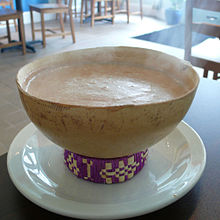
This list of hot drinks comprises drinks that are typically served hot. Drinks are liquids specifically prepared for human consumption.

This list of hot drinks comprises drinks that are typically served hot. Drinks are liquids specifically prepared for human consumption.
| Name | Image | Origin | Description |
|---|---|---|---|
| Aleberry | Made by boiling ale with spice (such as nutmeg), sugar and bread-sops, the last commonly toasted. It is sweetened, strained, and drunk hot. | ||
| Anijsmelk | Dutch drink, consisting of hot milk flavored with anise seed and sweetened with sugar | ||
| Apple cider |  | Popular fall (autumn) and winter beverage [1]
| |
| Asiático |  | Popular hot drink from Cartagena, Spain, consisting of coffee with condensed milk and cognac. [2] | |
| Atole |  | Traditional masa-based hot corn based beverage of Mexican and Central American origin, where it is known as atol
| |
| Bajigur | Hot and sweet beverage native to the Sundanese people of West Java, Indonesia. The main ingredients are coconut milk and Aren palm sugar; usually to add taste, a small amount of ginger and a small pinch of salt. | ||
| Bandrek |  | West Java, Indonesia | Traditional hot, sweet and spicy beverage native to Sundanese people of West Java, Indonesia. [3] It's a mixture of jahe (ginger) essence, gula merah (palm sugar) and kayu manis (cinnamon). [3] |
| Blackberry demitasse | Cocktail made from blackberry brandy or liqueur, blackberry jelly, cognac, water and lemon juice. It is served hot in a demitasse with a slice of lemon. [4] | ||
| Blue Blazer |  | Flaming cocktail made from Scotch or Irish Whiskey, honey, boiling water and lemon peel. It is served steaming hot for slow sipping. [4] | |
| Bouillon |  | Includes clam, tomato, oyster, chicken, asparagus bouillon and others, served at soda fountains in the United States in the early 1900s. [5] Food extracts such as beef extract were also used to prepare beef-flavored drinks add flavoring to other drinks at U.S. soda fountains during this time. [5] The beef variety was sometimes referred to as "beef tea". [6] Olives were often used in these bouillon drinks and those that were salty. [5]
| |
| Butter tea | 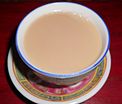 | Tibet | Also known as po cha, a drink of Tibet, Nepal, Bhutan, and Buddhist minorities in India, made from tea leaves, yak butter, water, and salt. Drinking butter tea is a regular part of Tibetan life. Before work, a Tibetan will typically enjoy several bowlfuls of this beverage, and it is always served to guests. Nomads are said to often drink up to 40 cups of it a day. Since butter is the main ingredient, the drink provides plenty of caloric energy and is particularly suited to high altitudes. The butter may also help prevent chapped lips. |
| Cannabis tea |  | A cannabis-infused drink prepared by steeping various parts of the cannabis plant in hot or cold water. | |
| Caudle |  | British thickened and sweetened alcoholic hot drink, somewhat like eggnog. It was popular in the Middle Ages for its supposed medicinal properties. | |
| Coffee |  | There are several accounts of the historical origin of coffee.
| |
| Hot egg drinks [5] | Phosphate soda and beverages were made with fruit flavorings, egg, malt, or wine. They became popular among men in the 1870s in the United States, and in the 1900s, the beverages became popular with both men and women. Fruit-flavoured phosphate sodas were served at soda fountains, before losing popularity to ice cream beverages in the 1930s. [7] | ||
| Espresso |  | Coffee brewed by forcing a small amount of nearly boiling water under pressure through finely ground coffee beans. Angelo Moriondo's Italian patent for a steam-driven "instantaneous" coffee beverage making device, which was registered in Turin in 1884 (No. 33/256), is notable. Author Ian Bersten, whose history of coffee brewers is cited below, claims to have been the first to discover Moriondo's patent. [9] Bersten describes the device as "... almost certainly the first Italian bar machine that controlled the supply of steam and water separately through the coffee" and Moriondo as "... certainly one of the earliest discoverers of the expresso [ sic ] machine, if not the earliest." The term espresso, substituting s for most x letters in Latin-root words, with the term deriving from the past participle of the Italian verb esprimere, itself derived from the Latin exprimere, means 'to express', and refers to the process by which hot water is forced under pressure through ground coffee. [10] [11] Types of espresso drinks include:
| |
| Hot ginger cordial | Served at U.S. soda fountains in the early 1900s [5] | ||
| Greyana rakiya | 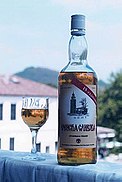 | Boiled rakiya; a winter alcoholic beverage in Bulgarian cuisine prepared with grape or plum brandy and honey [12] | |
| Grog | 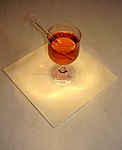 | Refers to a variety of alcoholic beverages. Modern versions are often made with hot or boiling water, and sometimes include lemon juice, lime juice, cinnamon or sugar to improve the taste. Rum with water, sugar, and nutmeg was known as bumbo and was more popular with pirates and merchantmen. | |
| Herbal tea | 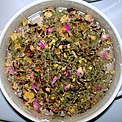 | Any beverage made from the infusion or decoction of herbs, spices, or other plant material in hot water, and usually does not contain caffeine. [13] These drinks are distinguished from true teas that are prepared from the cured leaves of the tea plant, Camellia sinensis . | |
| Hot buttered rum | 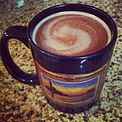 | Mixed drink containing rum, butter, hot water or cider, a sweetener, and various spices, usually cinnamon, nutmeg, and cloves | |
| Hot chocolate [8] [14] |  | Also known as hot cocoa, it typically consists of shaved chocolate, melted chocolate or cocoa powder, heated milk or water, and sugar. Hot egg chocolate is a type of hot chocolate. [5] [8] | |
| Hot toddy | 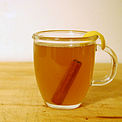 | Mixed drink made of liquor and water with sugar and spices and served hot. [15] | |
| Irish coffee | 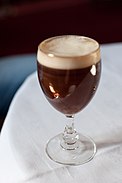 | Cocktail consisting of hot coffee, sugar and Irish whiskey, topped with thick cream | |
| Hot lemonade [8] |  | Claret lemonade is a type of hot lemonade [8] | |
| Yulmu-cha | In Korea, a thick drink called yulmu cha (율무차, literally "Job's tears tea") is made from powdered Job's tears. | ||
| Malted milk [5] [6] [8] |  | Powdered gruel made from a mixture of malted barley, wheat flour, and whole milk, which is evaporated until it forms a powder. Brands of malted milk include:
| |
| Mate cocido |  | Infusion typical of Southern Cone cuisine (mostly consumed in Southern Brazil, Argentina, Paraguay and Uruguay). It is traditionally prepared by boiling yerba mate in water, then strained and served in cups. | |
| Mulled wine |  | Usually made with red wine along with various mulling spices and raisins. Wine was first recorded as spiced and heated in 1st century Rome.[ citation needed ]
| |
| Posset |  | British hot drink of milk curdled with wine or ale, often spiced, which was popular from medieval times to the 19th century. It was typically prepared with milk that was heated to a boil, then mixed with wine or ale, which curdled it, and the mixture was usually spiced. [16] | |
| Postum | 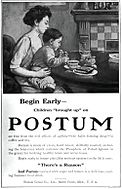 | Roasted grain beverage that was popular as a coffee substitute during World War II. | |
| Rüdesheimer Kaffee |  | Alcoholic coffee drink from Rüdesheim am Rhein in Germany invented in 1957 by the German television chef, Hans Karl Adam . [17] | |
| Sake |  | Traditional Japanese beverage which is produced from fermented rice and may be served hot | |
| Salep | 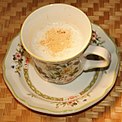 | Turkish beverage made of tubers of some Orchid species. Also known as sahlep. Served with cinnamon and sometimes mahlep. | |
| Sassafras tea |  | Tastes much like root beer but was traditionally drank hot or cold in the southern United States. [18] | |
| Smoking bishop | 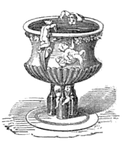 | Type of mulled wine punch or wassail that was especially popular in Victorian England at Christmas time | |
| Soda | 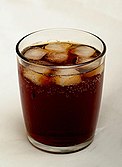 | Historically, hot sodas were served at soda fountains [5] [6] [8] | |
| Spiced punch [14] |  | Spiced punch served hot | |
| Tea [14] |  | The exact inventor of tea is unknown, but Chinese legends attribute the invention of tea to Shennong in 2737 BC. [19] Pictured is a cup of Earl Grey black tea.
| |
| Wedang Jahe | 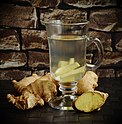 | Indonesia | An Indonesian ginger tea |
There are many hot beverages that originated from India that have gained popularity in other countries. For example, chai [21] (also known as masala chai) is a spiced milk tea that has become very popular throughout the world. Coffee also became a popular hot beverage in India, especially filtered coffee.



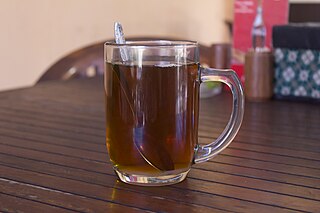
A drink or beverage is a liquid intended for human consumption. In addition to their basic function of satisfying thirst, drinks play important roles in human culture. Common types of drinks include plain drinking water, milk, juice, smoothies and soft drinks. Traditionally warm beverages include coffee, tea, and hot chocolate. Caffeinated drinks that contain the stimulant caffeine have a long history.

Tea is an aromatic beverage prepared by pouring hot or boiling water over cured or fresh leaves of Camellia sinensis, an evergreen shrub native to East Asia which probably originated in the borderlands of southwestern China and northern Myanmar. Tea is also made, but rarely, from the leaves of Camellia taliensis. After plain water, tea is the most widely consumed drink in the world. There are many different types of tea; some have a cooling, slightly bitter, and astringent flavour, while others have profiles that include sweet, nutty, floral, or grassy notes. Tea has a stimulating effect in humans, primarily due to its caffeine content.

Cappuccino is an espresso-based coffee drink that is traditionally prepared with steamed milk including a layer of milk foam.

Espresso is a concentrated form of coffee produced by forcing hot water under high pressure through finely ground coffee beans. Originating in Italy, espresso has become one of the most popular coffee-brewing methods worldwide. It is characterized by its small serving size, typically 25–30 ml, and its distinctive layers: a dark body topped with a lighter-colored foam called crema.

A posset was originally a popular British hot drink made of milk curdled with wine or ale, often spiced, which was often used as a remedy.

Caffè latte, also known as caffè e latte, caffellatte, or caffelatte, commonly shortened to just latte in English, is a coffee drink of Italian origin made with espresso and steamed milk, traditionally served in a glass. Variants include the chocolate-flavored mocha or replacing the coffee with another beverage base such as masala chai, mate, matcha, turmeric or rooibos; alternatives to milk, such as soy milk, coconut milk, almond milk or oat milk, are also used.

Coffee is a beverage brewed from roasted, ground coffee beans. Darkly colored, bitter, and slightly acidic, coffee has a stimulating effect on humans, primarily due to its caffeine content. It has the highest sales in the world market for hot drinks.

Teh talua or teh telur is a tea beverage from West Sumatra, Indonesia. The tea is unique due to its use of egg yolk in its preparation. Chicken or duck egg can be used to prepare the tea. Other ingredients, in addition to tea and egg yolk, include sugar and calamondin.

The history of tea spreads across many cultures throughout thousands of years. The tea plant Camellia sinensis is native probably originated in the borderlands of southwestern China and northern Myanmar. One of the earliest accounts of tea drinking is dated back to China's Shang dynasty, in which tea was consumed in a medicinal concoction. An early credible record of tea drinking dates to the 3rd century AD, in a medical text written by Chinese physician Hua Tuo. It first became known to the western world through Portuguese priests and merchants in China during the early 16th century. Drinking tea became popular in Britain during the 17th century. To compete with the Chinese monopoly on tea, the British East India Company introduced commercial tea production to British India.
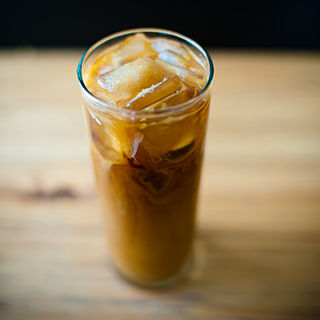
Iced coffee is a coffee beverage served cold. It may be prepared either by brewing coffee normally and then serving it over ice or in cold milk or by brewing the coffee cold. In hot brewing, sweeteners and flavoring may be added before cooling, as they dissolve faster. Iced coffee can also be sweetened with pre-dissolved sugar in water.

A caffè mocha, also called mocaccino, is a chocolate-flavoured warm beverage that is a variant of a caffè latte, commonly served in a glass rather than a mug. Other commonly used spellings are mochaccino and also mochachino. The name is derived from the city of Mokha, Taiz Governorate, Yemen, which was one of the centres of early coffee trade. The name is sometimes shortened to just mocha.

Cuban espresso, also known as Café Cubano, is a type of espresso that originated in Cuba. Specifically, it refers to an espresso shot which is sweetened. However, the name can refer to coffee based drinks that include Cuban espresso as the main ingredient, such as café con leche.

Lungo, known in full in Italian as caffè lungo, is a coffee beverage made by using an espresso machine to make an Italian-style coffee—short black with more water, resulting in a larger coffee, a lungo.

Ginger tea is a herbal beverage that is made from ginger root. It has a long history as a traditional herbal medicine in East Asia, South Asia, Southeast Asia, and West Asia.

Caffè d'orzo, often shortened to simply orzo, is a type of hot drink, originating in Italy. Orzo is a caffeine-free roasted grain beverage made from ground barley. It is an espresso-style drink, and when prepared from the roasted barley directly, it can easily be made in typical espresso machines and coffeemakers. In Italy it is widely available in coffee vending machines and traditionally considered a coffee substitute for children.

Mazagran is a cold, sweetened coffee drink that originated in Algeria. Portuguese versions may use espresso, lemon, mint and rum, and Austrian versions are served with an ice cube and include rum. Sometimes a fast version is achieved by pouring a previously sweetened espresso in a cup with ice cubes and a slice of lemon. Mazagran has been described as "the original iced coffee".

Masala chai is a popular beverage throughout South Asia, originating in India. It is made by brewing black tea in milk and water, and then by sweetening with sugar. Adding aromatic herbs and spices creates masala chai.
year 1996-2012